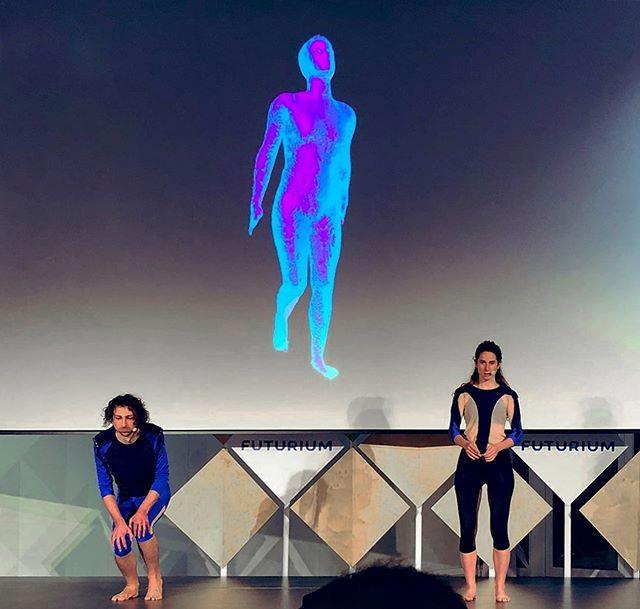
A REPLICA project in two phases, The Shape of Things to Come is an interdisciplinary project combining theatre, speculative fiction, and machine learning analysis. Created by Diana Neranti with a grant from the VolkswagenStiftung through the Wizenbaum-Institut für die vernetzte Gesellschaft, it consists of a workshop, for which technological systems were developed, and a performance, for which theoretical frameworks were refined, the sum of which provide a groundwork for potential future research and projects.
While much contemporary machine learning research is shaped by the categories and biases of its developers, we would like to critique and enhance this research with theatrical practise. Theatre is the realm where humans recognise each other qua humans, whether in the dramatic narratives that they recount, or the raw behaviours and emotions that are exposed and exchanged on stage. Moreover, it has been a quintessential realm of the corporeal, a perspective sorely lacking by the normally disembodied and delocalized computing, but one which will only become more relevant with the advent of the Internet of things and wearable electronics. By analyzing embodied, dramatic moments with a machine learning approach, we hope to gain insight into what is fundamentally human, and propose new human-centric models for the AI future. We then bring these models into present imagination (and imaginaries) by generating speculative futures and pouring them back into theatrical performance to share them.
Phase one consisted of the development of a system for capturing biometric data and an intensive theatre workshop during which the participants' qualitative and quantitative data would be collected1, to be fed into a machine learning algorithm to look for patterns. This entailed a large number of moving parts, and people to see to them: Diana and Régis Lemberthe administered the project, the largest REPLICA undertaking to date by far, and the amount of necessary coordination between the multiple organisations involved and their individual bureaucratic requirements cannot be understated. To develop the prototypes for the workshop, two symposia with representatives from the relevant fields were convened, titled The Council of Experts, which took place at the Weizenbaum-Institut2. On the basis of this input, the data-capturing system was designed, consisting of wearable components, developed by Mika Satomi of Kobakant, Erika Koerner, and Meredith Thomas, and a stereoscopic motion-tracking camera setup built by Gilbert Sinnott. The theatre workshop was led by Matej Matejka, Ditte Berkley, and Ilona Krawczyk, who were chosen for their rigorous, Post-Grotowskian style of work, and its focus on body and voice; Grotowskian practises were chosen for their analytical, almost scientific bent and focus on corporeality, critical for our focus on embodiment. Wenzel Mehnert, a research assistant at the Department of Time-Based Media at the UdK, headed qualitative research for the workshop, designing journals3 for each of the participants to document their subjective impressions and conducting video interviews with them and the facilitators. Previous REPLICA collaborator Joana Chicau and Kate Ryan, a performer at Studio Kokyu, joined Wenzel, Diana, and Régis in organizing logistics and theoretical frameworks for the workshop. Taking part in the workshop were: Gabriel Almagro, Jie Liang Lin, Saraï Ogara, Luke Swenson, and Peter Tommila, in addition to myself, Diana, Wenzel, Kate, and Joana. (It should be noted, however, that this rough division of labour is highly reductionist, not to mention filtered through my understanding (or lack thereof), and the whole process was more collaborative and all-hands-on-deck than any simplistic titles or descriptors could suggest.) The workshop took place over the course of two weeks in August 2019, the first week at Eden***** in Pankow, and the second at Gutshof Sauen, in the forests of Brandenburg.
After the workshop, a third Council of Experts symposium was held in September with participants from eight countries, across myriad disciplines, including neuroscience, phenomenology, design, and performance, to exchange knowledge, present our progress, and discuss the possibility of founding the project as an ongoing research initiative, and which I was delighted to be able to moderate. It was an intense two days, but equally intensely fascinating, with gratifying enthusiasm from all participants.
Phase two is a performance intended to output the insights gained in phase one and advance its theoretical underpinnings and speculative worldbuilding. Though continually postponed throughout 2020 due to restrictions imposed by the Covid-19 Pandemic, we nevertheless managed to convene in late November to rehearse, and the filmed output, Dancing at the Edge of the World, was finally livestreamed in March 2021.

Along with Saraï, I also performed in an intermediate output of the project in October 2019 at Künstliche Intelligenz*innen, a symposium on critical perspectives on AI at the new museum Futurium, in cooperation with the Weizenbaum-Institut. There, we performed a short movement-sound piece with a reactive projection that Meredith modified from Waltz Binaire, in conjunction with a presentation that Diana gave on gender bias and AI.